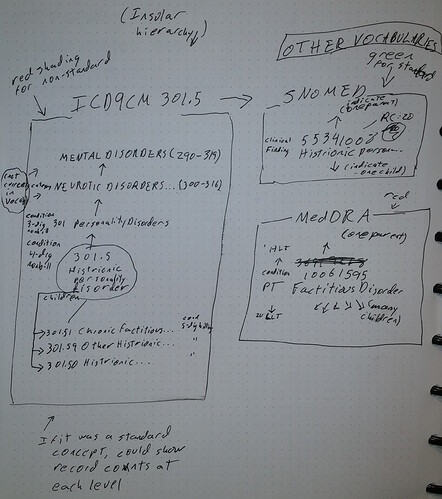I have to admit that I’m not entirely following all the details here, but I’ve been thinking for a while that we need to improve the vocabulary browser. I’ve drawn a little mockup below. I should probably have used a drug as an example (since that’s what I’m working on right now), but this shows an ICD9 code.
It gives a lot less information than the current browser on a given page, but I think arranges it more understandably and gives easy access and a clear path to anywhere you might want to navigate from a single concept.
On the left side is the “insular” hierarchy for the concept’s own vocabulary. There’s a path up to the root (for ICD9 I took the liberty of going up beyond the CDM’s root to the ICD9 categories) above and entries for children below. In this case the vocabulary has only one more level going down. One is probably all that should be shown anyway, but maybe with some indication of how many descendants each child has.
To the right of the insular hierarchy is a set of boxes showing the other vocabularies this concept is linked to. Each of these boxes focuses on the closest related concept and gives some indication of what one might find by navigating up or down in that vocabulary’s hierarchy from that concept. (If the focus concept is directly related to more than a single concept in some other vocabulary, that vocabulary could show up in multiple boxes.)
Whichever boxes contain standard concepts (SNOMED here) would be shaded green and contain record counts; the others would be shaded red.
In this example the concepts only have a single path going up for any given vocabulary, and of course that won’t always be the case, so the paths going up could be somewhat more complex. But since the only hierarchies shown are insular to a specific vocabulary, they shouldn’t be terribly unmanageable. Or, in cases where they are, we could just show a single level upwards with indications from each parent of what you’ll find by continuing to proceed upwards.
What do you think? What would be lost by keeping all hierarchical representation “insular” to specific vocabularies? If it’s not sufficient to show the insular hierarchy plus the bridges to hierarchies in other vocabularies, I think this UI idea could be extended, but I don’t really know what people need in this regard.
